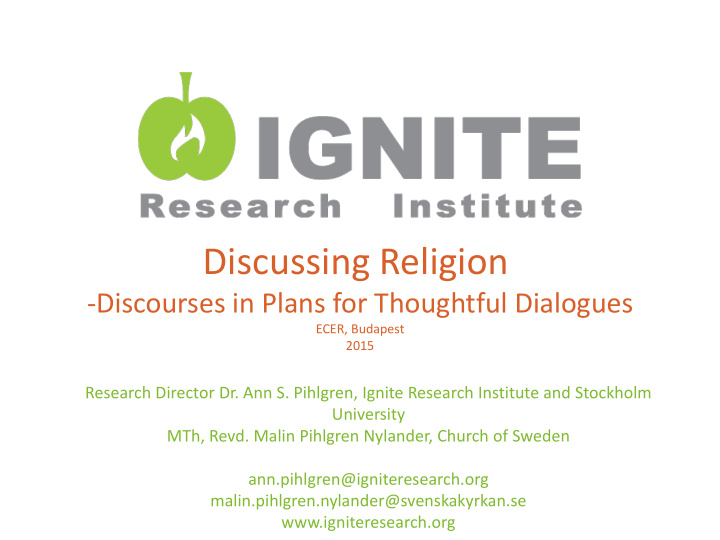



Discussing Religion -Discourses in Plans for Thoughtful Dialogues ECER, Budapest 2015 Research Director Dr. Ann S. Pihlgren, Ignite Research Institute and Stockholm University MTh, Revd. Malin Pihlgren Nylander, Church of Sweden ann.pihlgren@igniteresearch.org malin.pihlgren.nylander@svenskakyrkan.se www.igniteresearch.org
Thoughtful dialogues Methods for philosophizing with students: P4C/ PwC Philosophy for/ with children Socratic (Paideia) seminars Socratic dialogues Deliberative dialogue Open ended questions Investigative, critical analysis Collaborative dialogue Ultimate goal is to enhance and develop students’ Democratic competences p articipation in “the Great Conversation of Mankind”
Research questions What discourses can be found in methodological materials for thoughtful dialogue addressing the subject religion? Are questions in the materials used to address faith, morality, and teaching? If so, how? How are the discourses found in the methodological materials related to the discourses in religious education in a highly secularized country (Sweden)?
Fairclough’s (2013:73) three-dimensional conception of discourse SOCIAL PRACTICE DISCURSIVE PRACTICE TEXT Three nodal points: Faith, morality, teaching
The World Value Survey Cultural Map 2005-2008
Traditional /secular-rational values Religion considered very important or not Traditional pole: Importance of parent-child ties and deference to authority Absolute standards Traditional family values High levels of national pride, and a nationalistic outlook Societies with secular-rational values: Opposite preferences on all of these topics A shift from traditional toward secular-rational values in almost all industrial societies
Survival/ self-expression values Linked with the transition from industrial society to post-industrial societies From economic and physical security towards self- expression and quality of life Self-expression values: High priority to environmental protection Tolerance of diversity Demands for participation in decision making High ranking on self-expression values tends to rank high on interpersonal trust Research defines this as crucial to democracy Theologies shift from religious truths towards a personal relation to God found in dialogue with others
Theology and dialogue God-talk Critique of the thought that secularization leads to decline of religion Miscommunication in society – religious dialogue necessity for democracy From hierarchical model of truth to dialogical model of truth – self-criticism and speaking boldly Openness and contextuallity
United Nations: Convention on the Rights of the Child (14:1) “States Parties shall respect the right of the child to freedom of thought, conscience and religion.”
Three discourses were found: Critical thinking in school Teaching philosophy in school Critical thinking in religion
Allah will provide A North African folktale from Great Books, grade 4
Critical thinking in school Most frequent discourse Uses “teacher aid” and “text book” layout Aims at transforming teaching Uses religious texts but questions of faith are avoided
Nous A Pixie story from Matthew Lipman, grade 5-6
Teaching philosophy in school Uses “teacher education” layout Faith is not addressed Moral questions and the egalitarian dialogue are elements used to justify teaching philosophy in school
Jacob and Esau A Bible text from Våra bästa samtal, grade 5->
Critical thinking in religion Does not use teaching material layout (instruction or worksheet) Questions of faith and morality are addressed Critical analysis of ethical and theological questions
Four approaches to religious education in school The attitude towards questions of faith Addressing questions of faith Avoiding questions of faith A. DOGMATIC RELIGION B. DOGMATIC ATHEISM FAITH: Religious faith is seen FAITH: Religious faith is seen as Fundamental ist approach as true dogmas and superstition, or a personal matter, and is right/wrong ways to believe. not seen as worth exploring. MORALITY: True morals, based MORALITY: A set of fundamental values, The approach to knowledge on a certain religion, are based on societal agreements are taught. taught. TEACHING: The teacher mediates the TEACHING: The teacher material to the students. Religious mediates the material to the education focuses on teaching facts about students. different religions. Present Swedish C. EXAMINING THEOLOGY D. EXAMINING PHILOSOPHY EXCLUDING curriculum FAITH : Rational critical THEOLOGY Critical examination approach theological examination of FAITH: Religion is seen as a personal questions of faith is matter or as superstition and cannot be encouraged. analyzed, or all views are accepted, MORALITY: Moral questions encouraging relativism. are examined, analyzed, and MORALITY: Moral questions are discussed. examined, analyzed, and discussed. TEACHING: Scaffolding, TEACHING: Scaffolding, dialogic and dialogic and critically critically examining methods are used. examining methods are used. Religious education focuses on teaching facts about different religions.
You find the paper and the slideshow at: www.ingniteresearch.org/library
Recommend
More recommend